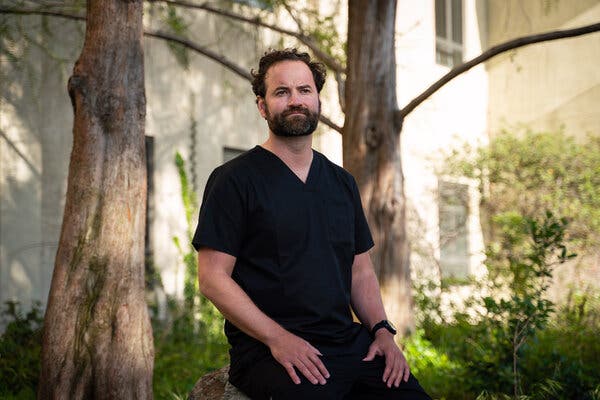Hundreds Reported Abnormal Menstruation After Exposure to Tear Gas, Study Finds
A scientific paper expands on social media reports of sudden onset of periods, spotting and other menstrual peculiarities during last summer’s protests in Portland, Ore.At some point last summer, there were just too many reports of protesters who had experienced abnormal menstrual cycles after being exposed to tear gas for Britta Torgrimson-Ojerio, a nurse researcher at the Kaiser Permanente Center for Health Research in Portland, to dismiss them as coincidence.A preschool teacher told Oregon Public Broadasting that if she inhaled a significant amount of gas at night, she’d get her period the next morning. Other Portland residents shared stories of periods that lasted for weeks and of unusual spotting. Transgender men described sudden periods that defied hormones that had kept menstruation at bay for months or years.Dr. Torgrimson-Ojerio decided she would try to figure out whether these anecdotes were outliers or representative of a more common phenomenon. She surveyed around 2,200 adults who said they had been exposed to tear gas in Portland last summer. In a study published this week in the journal BMC Public Health, she reported that 899 of them — more than 54 percent of the respondents who potentially menstruate — said they had experienced abnormal menstrual cycles.“Even though we cannot say anything scientifically definitive about these chemical agents and a causal relationship to menstrual irregularities,” Dr. Torgrimson-Ojerio said, “we can definitively say that in our study most people who had menstrual cycles or a uterus reported menstrual irregularities after reporting exposure to tear gas.”Downstream effects, like the impact on fertility, are not known, but “this is our call to action to ask our scientific community to turn their eye to this issue,” she said.Dr. Torgrimson-Ojerio was also interested in whether people had experienced other problems more than a few hours after being exposed to tear gas. She found that 80 percent of survey participants had, with difficulty breathing being among the most prevalent complaints.Kira Taylor, a professor of epidemiology and population health at the University of Louisville School of Public Health and Information Sciences who is conducting a similar study, said that Dr. Torgrimson-Ojerio’s study provided “some of the first solid evidence” that tear gas might be linked to menstrual abnormalities. It is also “the first study to document the longer-term effects of tear gas exposure in a large population,” she said.Sven-Eric Jordt, a professor of anesthesiology, pharmacology and cancer biology at the Duke University School of Medicine, who was not involved in the study, applauded the work.A tear gas canister striking a barrier in Portland in July.Mason Trinca for The New York TimesMost of the research that police agencies and the government rely on to inform them about tear gas safety “are outdated, often 50 to 70 years old, and don’t measure up to modern toxicological approaches,” he said. “Most of these studies were conducted in young healthy men at the time, either police or military, and not in women, or in a general civilian population representing protesters.”Dr. Torgrimson-Ojerio and her colleagues recruited survey participants through social media and links on the websites of The Oregonian and the Oregon Health Authority in July and August.The researchers asked participants to explain precisely how their periods had been affected after exposure to tear gas. Increased cramps, unusual spotting and uncharacteristically intense or long bleeding were the most common reactions. A number of people who don’t usually have periods because of hormone therapy or age reported unexpected bleeding and spotting, Dr. Torgrimson-Ojerio said.This study has limitations. It is not a random sample.“It is possible that people who feel that their health was damaged by tear gas might have been more likely to respond than people who were also exposed, yet did not feel such harmful effects,” Dr. Taylor said. “This means that some of the numbers might be exaggerated.”Given that subjects were permitted to participate anonymously, researchers could not verify their accounts.A spent canister of CS gas that was fired during a protest at the Immigration and Customs Enforcement building in Portland in January.Alisha Jucevic for The New York TimesNor can the study answer how or why tear gas might be contributing to menstrual irregularities or to what extent other factors are also involved. The authors acknowledge that the high levels of stress and anxiety among protesters, for example, could also have contributed to the physical response.“It is possible that pain, stress, dehydration and exertion play a role,” Dr. Jordt said. Alternatively, tear gas may act as an “endocrine disrupter,” interfering with normal hormonal function.“The tear gas agent CS, sometimes used by police, is a chlorinated chemical compound and produces additional chlorinated byproducts when burned in the canisters used by the police,” he said. “Exposure to chlorinated chemicals can affect menstrual health.”Alexander Samuel, a molecular biologist in France, has been investigating similar questions since French protesters began reporting menstrual irregularities.He mentioned two additional areas for exploration: whether tear gas is metabolized into cyanide, which may cause heavy menstrual bleeding, and the role a traumatic event may play in altering menstrual cycles.Suspicions about tear gas and menstruation first came up more than a decade ago, during the Arab Spring protests, Dr. Jordt noted.In 2011, Chile also banned the use of tear gas after a study suggested that CS gas could cause miscarriages and harm young children. Three days later, the Chilean police lifted the ban, insisting that the type of tear gas they used was perfectly safe.
Read more →





